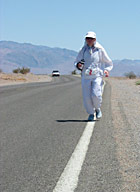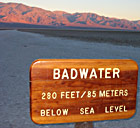Braving the Badwater Ultramarathon
Hard-Core Athletes Run 135-Mile Death Valley Road Race
 Ultramarathon runner Angela Brunson runs through the 123-degree heat of Death Valley. Photo: Andy Bowers, NPR News |
|
"Basically, I think of this event as a connect the dots from ice cream stop to ice cream stop. You know, whatever works."
|
 An onimous place to start -- 280 feet below sea level in California's Death Valley. Photo: Andy Bowers, NPR News |
|
"I've seen Boeing 747s pull up beside me, and green lizards on the road that don't exist, a gal clad in a bikini rollerblading in front of me that didn't exist. They don't frighten me anymore, they're more entertaining. It's just your mind just giving you a little bit of a break from the monotony of it all, I believe."
|
July 31, 2002 -- To most athletes or would-be athletes, finishing a 26.2-mile marathon may seem like a huge accomplishment. But for some hard-core runners, it's just the beginning.
Many elite runners compete in so-called ultramarathons, covering 50 or even 100 miles. But some consider the Badwater Ultramarathon the true test of the committed runner -- 135 miles through the deadly summer heat of Death Valley, beginning at the lowest point in North America and ending halfway up the tallest peak in the lower 48 states.
NPR's Andy Bowers followed one runner last week through what's often called the toughest foot race in the world. Bowers followed in the brave footsteps of Angela Brunson, a first-time Badwater competitor and deputy district attorney for the County of Los Angeles. Brunson, already an experienced marathon and ultramarathon runner, was one of 79 competitors in this year's event.
"It's not necessarily that I want to do it," she told Bowers before the race began. "The way I refer to it I was kind of sucked into it -- you know, like a tractor beam. You can't really escape the magnetism of this event."
Brunson trained for countless hours on desert roads and treadmills. And to get used to the heat, she also trained in saunas. Her goal is to complete the course within 48 hours. Runners who get in under that deadline are awarded a coveted belt buckle to signal their endurance.
"(It) sounds really silly, but to other ultra-runners, if you say that you have buckled at Badwater, it's quite an accomplishment," she says. "But to people on the street, everyday, you tell them you got a buckle for running this insane distance, they immediately want to lock you up."
This year, the race begins early in the morning on July 23 at Death Valley's Badwater salt flats, 280 feet below sea level. The temperature is already in the high 90s. At exactly 6 a.m., the man who made the first solo trek from Badwater to Mt. Whitney 25 years ago, Al Arnold, yells "bang!" in lieu of firing a starter's pistol.
Along the course, the runners race past ominous-sounding Death Valley landmarks such as Furnace Creek and Dante's Peak, while their support crews motor ahead in a fleet of minivans and trucks. Brunson's crew includes her boyfriend, Brian Seaver.
That afternoon, the temperature soars to 123 degrees, with almost no humidity -- conditions that evaporate sweat, so runners can dehydrate fast. Support crews nag their runners to drink and drink, and then drink some more.
From time to time, Brunson allows herself a treat -- an ice cream sandwich. "Basically, I think of this event as a connect the dots from ice cream stop to ice cream stop," she says. "You know, whatever works."
She and the other runners endure the oppressive heat of the day and continue running until well after dark, taking cat naps when they can. After an hour and a half of rest, Brunson is back on the road, with nearly a full day's running ahead of her.
Meanwhile, halfway up Mt. Whitney at the finish line, history is being made. First-time entrant Pam Reed, 41, breaks the tape in just under 28 hours. She's the first woman to win a Badwater race, and she does it hours ahead of everyone else.
Other runners find different motivations to push themselves forward. Marshall Ulrich, 51, raced the Badwater this year for a record tenth time. Last year, he ran the full course -- plus up to the 14,495-foot summit of Mt. Whitney -- four times in succession, back and forth, in just 10 days.
But for Brunson, just finishing the Badwater is good enough. At about 3:30 a.m. on her second day of almost non-stop running, Brunson crosses the finish line. Not only has she beaten the 60-hour maximum time, she's beaten the 48-hour cutoff to earn her belt buckle. Her final time: 45 hours, 37 minutes, 20 seconds.
Will she return next year? "No, I don't have to come back now," she tells Bowers. "Mission accomplished. Done. Over with. Got it out of my system... I mean, ask me again in like a couple months."
Other Resources
* Badwater Ultramarathon official Web site